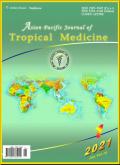有关流行病学、发病机理和治疗埃博拉病毒感染的小分子疗法开发的最新信息
IF 1.9
4区 医学
Q3 PUBLIC, ENVIRONMENTAL & OCCUPATIONAL HEALTH
引用次数: 0
摘要
埃博拉病毒病(EVD)是一种罕见的高传染性致命疾病,死亡率从 30% 到 90% 不等。过去二十年来,埃博拉疫情严重影响了撒哈拉以南地区,包括刚果民主共和国(DRC)和乌干达。大多数埃博拉病例的病原体是六种埃博拉病毒中的三种,即扎伊尔埃博拉病毒(ZEBOV)、苏丹埃博拉病毒(SUDV)和邦迪布京埃博拉病毒(BDBV)。近年来,治疗干预措施取得了重大进展。值得注意的是,美国食品和药物管理局已经批准了两种单克隆抗体:InmazebTM (REGN-EB3) 和 Ansuvimab 或 Ebanga™。此外,许多小分子药物目前正处于开发阶段,有望在医疗领域取得进一步进展。针对预防措施的迫切需要,本综述深入分析了已获许可的埃博拉疫苗--Ervebo 和 Zabdeno(Ad26.ZEBOV)与 Mvabea(MVA-BN-Filo)的组合疫苗,以及目前正在临床研究中进行有效性和安全性测试的疫苗。这些疫苗可能会在遏制这一致命疾病的传播和减轻其影响方面发挥重要作用。目前治疗 EVD 的方法包括营养(支持)疗法和药物疗法。这篇综述全面详述了 EVD 的起源、发病机制和流行病学,揭示了目前为抗击这一毁灭性疾病所做的努力。它探讨了处于不同开发阶段的小分子药物,讨论了已申请或已授权的专利,并深入研究了构成 EVD 治疗基石的临床和支持疗法。这篇综述旨在为科学界提供小分子设计和合成方面的最新进展,以促进对该疾病的深入了解,并推动制定预防、治疗和控制 EVD 的有效策略。本文章由计算机程序翻译,如有差异,请以英文原文为准。
Current updates on the epidemiology, pathogenesis and development of small molecule therapeutics for the treatment of Ebola virus infections
Ebola virus disease (EVD) is a rare, highly contagious and a deadly disease with a variable fatality rate ranging from 30% to 90%. Over the past two decades, Ebola pandemic has severely affected the sub-Sahara region including Democratic Republic of the Congo (DRC), and Uganda. The causative agents of the most EVD cases are three distinct species out of six Ebolaviruses namely Zaire Ebolavirus (ZEBOV), Sudan Ebolavirus (SUDV) and Bundibugyo Ebolavirus (BDBV). In recent years, significant strides have been made in therapeutic interventions. Notably, the US Food and Drug Administration has approved two monoclonal antibodies: InmazebTM (REGN-EB3) and Ansuvimab or Ebanga™. Additionally, many small molecules are currently in the developmental stage, promising further progress in medical treatment. Addressing the critical need for preventive measures, this review provides an in-depth analysis of the licensed Ebola vaccines-Ervebo and the combination of Zabdeno (Ad26.ZEBOV) and Mvabea (MVA-BN-Filo) as well as the vaccines which are currently being tested for their efficacy and safety in clinical studies. These vaccines might play an important role in curbing the spread and mitigating the impact of this lethal disease. The current treatment landscape for EVD encompasses both nutritional (supportive) and drug therapies. The review comprehensively details the origin, pathogenesis, and epidemiology of EVD, shedding light on the ongoing efforts to combat this devastating disease. It explores small molecules in various stages of the development, discusses patents filed or granted, and delves into the clinical and supportive therapies that form the cornerstone of EVD management. This review aims to provide the recent developments made in the design and synthesis of small molecules for scientific community to facilitate a deeper understanding of the disease and fostering the development of effective strategies for prevention, treatment, and control of EVD.
求助全文
通过发布文献求助,成功后即可免费获取论文全文。
去求助
来源期刊

Asian Pacific journal of tropical medicine
PUBLIC, ENVIRONMENTAL & OCCUPATIONAL HEALTH-TROPICAL MEDICINE
CiteScore
4.00
自引率
9.70%
发文量
1936
审稿时长
3-8 weeks
期刊介绍:
Asian Pacific Journal of Tropical Medicine (ISSN 1995-7645 CODEN: APJTB6), a publication of Editorial office of Hainan Medical University,is a peer-reviewed print + online Monthly journal. The journal''s full text is available online at http://www.apjtm.org/. The journal allows free access (Open Access) to its contents and permits authors to self-archive final accepted version of the articles on any OAI-compliant institutional / subject-based repository.
APJTM aims to provide an academic communicating platform for international physicians, medical scientists, allied health scientists and public health workers, especially those of the Asia-Pacific region and worldwide on tropical medicine, infectious diseases and public health, and to meet the growing challenges of understanding, preventing and controlling the dramatic global emergence and re-emergence of infectious diseases in the Asia-Pacific.
The journal is proud to have an international and diverse editorial board that will assist and facilitate the publication of articles that reflect a global view on tropical medicine, infectious diseases and public health, as well as emphasizing our focus on supporting the needs of public health practitioners. The APJTM will allow us to seek opportunities to work with others who share our aim, and to enhance our work through partnership, and to uphold the standards of our profession and contribute to its advancement.
 求助内容:
求助内容: 应助结果提醒方式:
应助结果提醒方式:


